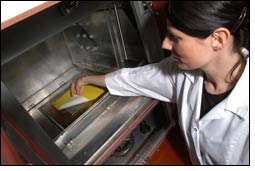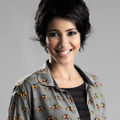Interviews
Sleep comfort is measurable
21 Jul '09
6 min read

On the basis of their investigations of bedcovers, scientists at Hohenstein have defined three thermal classes to ease orientation for retailers and consumers alike. By using a simple graph, the suitable thermal insulation class can be determined individually from the ambient nightly temperature in the bedroom and the body weight of the person sleeping. The lower the ambient temperature and the weight of the person sleeping, the greater the thermal insulation class required.
To illustrate, a person with a body weight of 50 kg produces just 62 watts in thermal energy, while a person weighing 110 kg produces 101 watts. Yet for both, the same skin temperature is necessary for them to feel comfortable and maintain body functions when sleeping. Therefore, the thermal insulation of a blanket for relatively lightweight individuals should be greater. The Hohenstein label for "Tested Quality" provides information on the thermal insulation of bedding. Manufacturers are using it increasingly to set their products apart from the rest.
From a physiological standpoint, which other factors play a role in selecting a bedcover in addition to thermal insulation?
In addition to featuring optimal thermal insulation, bedcovers should of course also have the capacity to conduct excess heat and perspiration away from the body of the person sleeping. Hohenstein researchers therefore evaluated textile materials using several methods – including a skin model.
They worked with different textile parameters that each represented a specific material property, including the management of moisture. Over the course of the years, the specialists have developed a complex predictive model that – with the help of values obtained form this laboratory – can be used to evaluate thermophysiological comfort of a finished product. This is presented in the form of what is known as a "sleep comfort mark", which ranges from 1 for "very good" to 4, for "inadequate". And once the optimal individual thermal insulation class has been determined, the sleep comfort mark is a decisive factor in selecting a suitable bedcover.
The Hohenstein label for "Tested Quality" gives sleep comfort marks for warm and cold climates. The body weight of the individual using a product and the room temperature likely during the period of use (summer, winter, year-round) are decisive in determining whether to apply the sleep comfort mark for a warm or a cold climate when choosing a bedcover. Here, a graph can be helpful in making a determination based on customer details. For a person weighing 80 kg, for example, the warm climate mark would be suitable for someone living in a region with an average annual temperature of 18 degrees Celsius. If average temperature value is lower than that, then the sleep comfort mark for a cold climate would be decisive in choosing the product.
How does bed linen contribute to a feeling of well-being during sleep?
Quality bed linen should primarily support the thermophysiological functioning of the bedcover, pillow and mattress. In order to make objective comparisons possible here, the Hohenstein label for "Tested Quality" gives physiological comfort marks for bed linen. These range from 1, for "very good", to 6, for "unsatisfactory".
What criteria can be used in evaluating mattress covers (encasings) for allergy sufferers?
Mattress covers impermeable to allergenic particles are a central feature of treatment for house dust mites and mould allergies. Yet by no means does the required density of the fabric rule out good breathability. Nevertheless, general statements about suitable material composition cannot be made here either, because it is the structure of the textile material determines whether it is sufficiently permeable to water vapour. The Hohenstein label for "Tested Quality" also provides a good orientation point in this respect, because it is only issued if the encasing material has demonstrated good breathability.
To illustrate, a person with a body weight of 50 kg produces just 62 watts in thermal energy, while a person weighing 110 kg produces 101 watts. Yet for both, the same skin temperature is necessary for them to feel comfortable and maintain body functions when sleeping. Therefore, the thermal insulation of a blanket for relatively lightweight individuals should be greater. The Hohenstein label for "Tested Quality" provides information on the thermal insulation of bedding. Manufacturers are using it increasingly to set their products apart from the rest.
From a physiological standpoint, which other factors play a role in selecting a bedcover in addition to thermal insulation?
In addition to featuring optimal thermal insulation, bedcovers should of course also have the capacity to conduct excess heat and perspiration away from the body of the person sleeping. Hohenstein researchers therefore evaluated textile materials using several methods – including a skin model.
They worked with different textile parameters that each represented a specific material property, including the management of moisture. Over the course of the years, the specialists have developed a complex predictive model that – with the help of values obtained form this laboratory – can be used to evaluate thermophysiological comfort of a finished product. This is presented in the form of what is known as a "sleep comfort mark", which ranges from 1 for "very good" to 4, for "inadequate". And once the optimal individual thermal insulation class has been determined, the sleep comfort mark is a decisive factor in selecting a suitable bedcover.
The Hohenstein label for "Tested Quality" gives sleep comfort marks for warm and cold climates. The body weight of the individual using a product and the room temperature likely during the period of use (summer, winter, year-round) are decisive in determining whether to apply the sleep comfort mark for a warm or a cold climate when choosing a bedcover. Here, a graph can be helpful in making a determination based on customer details. For a person weighing 80 kg, for example, the warm climate mark would be suitable for someone living in a region with an average annual temperature of 18 degrees Celsius. If average temperature value is lower than that, then the sleep comfort mark for a cold climate would be decisive in choosing the product.
How does bed linen contribute to a feeling of well-being during sleep?
Quality bed linen should primarily support the thermophysiological functioning of the bedcover, pillow and mattress. In order to make objective comparisons possible here, the Hohenstein label for "Tested Quality" gives physiological comfort marks for bed linen. These range from 1, for "very good", to 6, for "unsatisfactory".
What criteria can be used in evaluating mattress covers (encasings) for allergy sufferers?
Mattress covers impermeable to allergenic particles are a central feature of treatment for house dust mites and mould allergies. Yet by no means does the required density of the fabric rule out good breathability. Nevertheless, general statements about suitable material composition cannot be made here either, because it is the structure of the textile material determines whether it is sufficiently permeable to water vapour. The Hohenstein label for "Tested Quality" also provides a good orientation point in this respect, because it is only issued if the encasing material has demonstrated good breathability.
Hohenstein Institute
Popular News
Leave your Comments
Editor’s Pick
Kimberly Morgan and Rik Veltman
K3 Business Technology Group PLC
Amritha Ram
Brand - KH House of Khaddar
































-Ltd..jpg?tr=w-120,h-60,c-at_max,cm-pad_resize,bg-ffffff)





.jpg?tr=w-120,h-60,c-at_max,cm-pad_resize,bg-ffffff)
.jpg?tr=w-120,h-60,c-at_max,cm-pad_resize,bg-ffffff)






